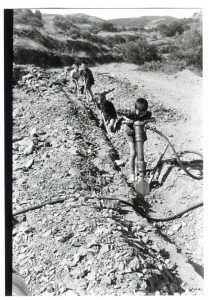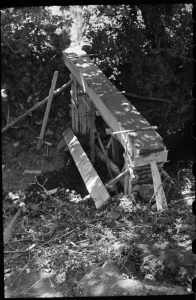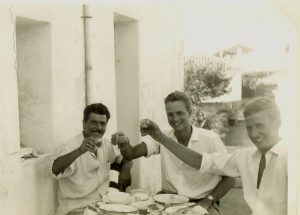The installation of water supply systems for the first three villages Logothetianika, Potamos and Diakopoulianika in 1962.
By Jean Bingen, February 2021.
This story is more in detail only about these three villages than the general story “Search for domestic water at Kythera in the sixties”.
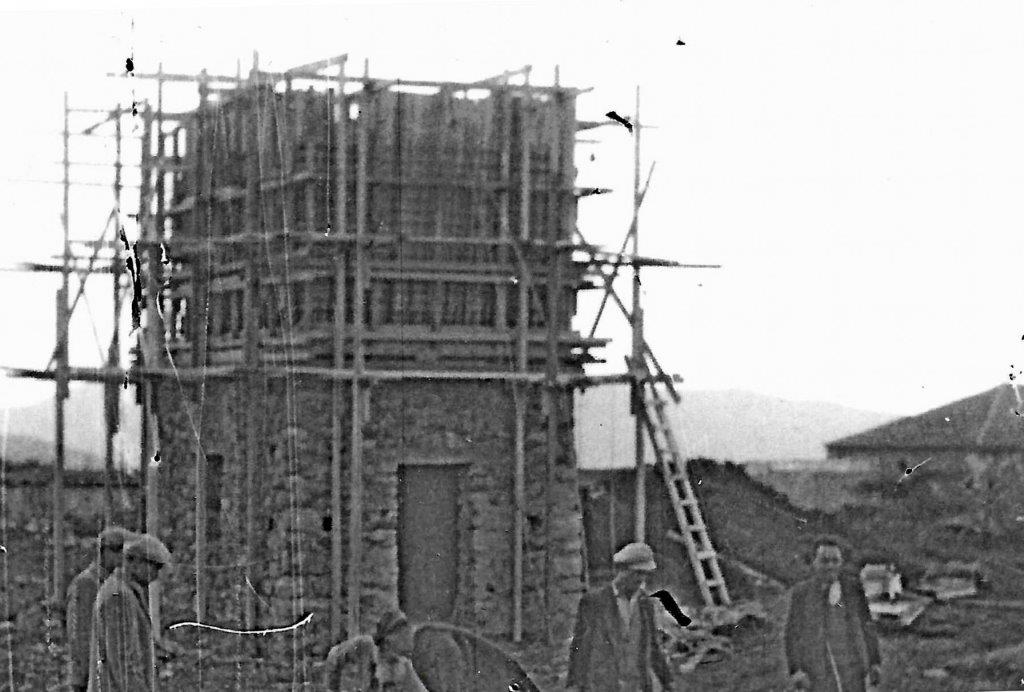
George (Jurjen) and Anna Koksma arrived at Kythira towards the end of April 1960.
Immediately they are confronted with the lack of water on the island, no community water supply available, people must take water from the village wells for public use, or from the wells inside the houses, for drinking and cleaning. This water is not always to be trusted and did cause sometimes illnesses. Rainwater is running straight to the sea, slopes of the hills are bare, not having a vegetation to retain the running water to allow a soaking into the soil.
The solution for the drinking water problem is to provide the villages with a sound water supply system: a cistern on a high location above the village and a closed pipe system to the houses. But where had the water to come from and how could you pump it into a cistern if there was no electricity? For the pipes was an answer, namely letters to Holland, to a plastic pipe fabricator who was willingly to donate a certain length of these pipes. But they, as well as the Greek authorities for official approval on the projects, wished to see surveys and technical layouts.
The actual surveys were done by George and Anna (!) and of course with some help of local people. In December 1960, the required technical drawings and pipe diameter designs were prepared by George and sent to Holland. (This part is copied from my article in the Kythera Summer Edition Water and Trees: 1960, (still an issue in 2010)
Being on vacation in Holland George meets Mr. van Veen in Zwolle end of March 1961. Mr. van Veen is an executive director of the Dutch pvc pipe fabricator Wavin and they discuss the delivery of pipes for Kythira. December 14 George receives a message that a donation of 10 tons of pvc pipes, including all fittings, is ready to be sent to Kythira. These pipes arrived April 17, 1962 at Kythira. The Team only had to pay the costs of freight from Piraeus to Kythira!
In this same vacation March/April 1961 in Holland, at a seminar George happened to discuss his wish of technical assistance with a teacher at the Technical High School Arnhem. Mr. Spliethoff thought this an interesting idea for students to gain practical experience. He proposed this idea to the Board of Directors and got this accepted. Many civil engineering students filled out application forms. The Team at Kythira selected four of them. The two most practical students, Martin and Wessel, were given a pipe fitting course at the pipe fabrication site at Hardenberg in the month before they left for Greece. Erik and I (Jean Bingen) were to learn this from them once being on the island.
From my diary: The four of us leave for Greece Sunday morning 28th of January 1962 at 10.15 hours by train from Arnhem railway station. We arrive at Athens on the 30th at approx. 18.00 h. Next morning 10 o’clock, we leave by ferryboat for Kythira where we arrive at Kapsali Thursday 1st of February at approx. 1.30 h.
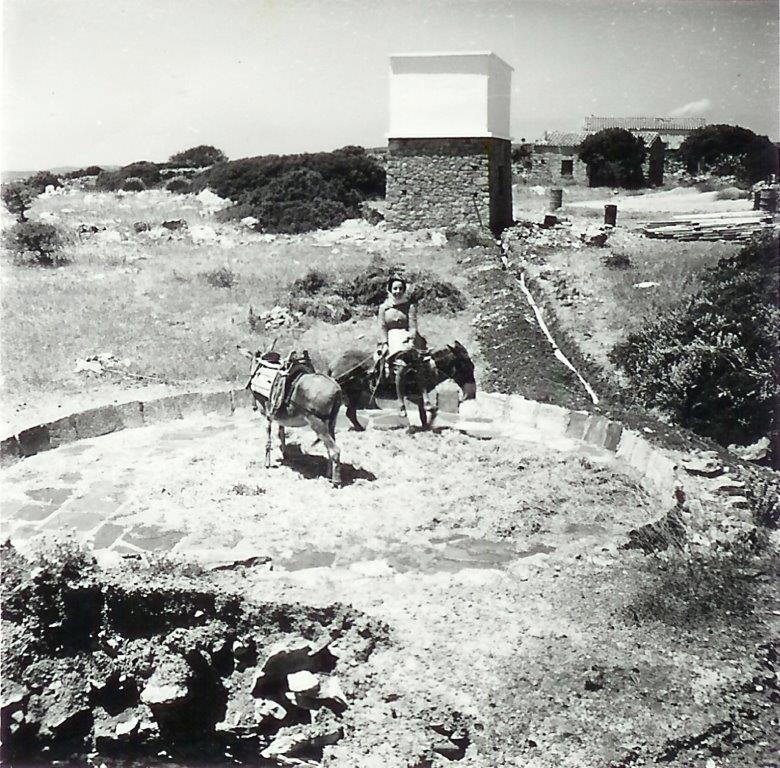


After unpacking in Kapsali of the crates with pipe fittings, transportation of pipes by trucks was started next day April 18. The following three days our duties were in Logothetianika and Potamos. In Logothetianika the organization of the required work was in good hands. A local contractor had constructed in heavy masonry the base for the water tower and with reinforcement drawings from the Team had already poured the concrete bottom. Now they were pouring the walls. For two days I was on site, mainly to watch that enough cover was applied on the reinforcement. Fresh mixed concrete in tin cans, lifted on shoulders up the ladder, was poured by hand in the formwork (first photo). The formwork at the inside was erected to full height and when pouring reached a certain level, new planks were slided in on the outside.
The Team held Easter vacation from April 25 through May 6. See my Dutch diary and see also “bi-weekly reports a summary of main topics”.
*Click on a photo to enlarge
**Click here for more photos of 1962
During our vacation, the work in Logothetianika and Potamos had been continued. Now on Monday May 7 Wessel was appointed to look after work done in Logothetianika as Martin was in Potamos. For two days Erik and I helped them laying pipes in these villages. Erik and I went to Diakopoulianika May 9, we were going to make a longitudinal survey from the water source Mangano across the narrow stream towards Diakopoulianika. To cross this stream a little bridge was required and the location for a pumpstation on the opposite hill side was to be marked. Once on the dirt road from Gerakari to Karavas the route through Diakopoulianika to the centre of Karavas could follow the drawings made by George Koksma. In all villages local labour by order of the village council dug the trenches. Whether they were paid or fulfilled a kind of labour duty to the community I did not know. In Potamos was a lot more work to be done. For that reason, Erik and I also helped Martin laying the pipes. Most of my time however I was looking after the work done in Karavas, occasionally with help from Erik. Garage owner Panayiotis Paskalis from Potamos several times had to make/supply steel T-valves or other steel parts to fit in between the plastic pipes, but his most important job was to keep our motor vehicles running.
As in three villages continuous trench digging by local labour was done, our supervising work was following:
– setting out the direction of the pipelines according to the drawings made by George Koksma
– to check if trench depth was sufficient, minimum 60 cm, which was sometimes not easy in extremely hard rocky ground
– to assure that finer outcoming material was stored separately from coarse material (not easy!)
– to ensure that backfilling at least 10 cm all around the pipe was done with sandy material to avoid damage by pieces of rocky material.

This meant that the four of us went job hopping from one village to another. When the condition of the trenches was deemed all right, we could install the pipes taking care that jointing of pipe length was done adequately, that no sharp obstacles were underneath, and that no tension in vertical and horizontal curves should occur. All these measures were required that no leakage should happen when pipes were tested, or in final use when roads had been repaired.
Normally we could have a paid lunch by the community or one of the villagers who spoke English and acted as interpreter took us to their home to have lunch with their family. In this way I got a lifetime friendship with several families in Karavas.
When were these water supply systems put in use?
- In Logothetianika this was in 1963. This can be read in Walter Stölting’s “Das Wasserleitungsfest von Logothetianika”.
- Potamos had to wait for the first successful Artesian well to be drilled and got its water in 1966.
- Diakopoulianika and Karavas got their water most probably in 1964, but I am not sure.





